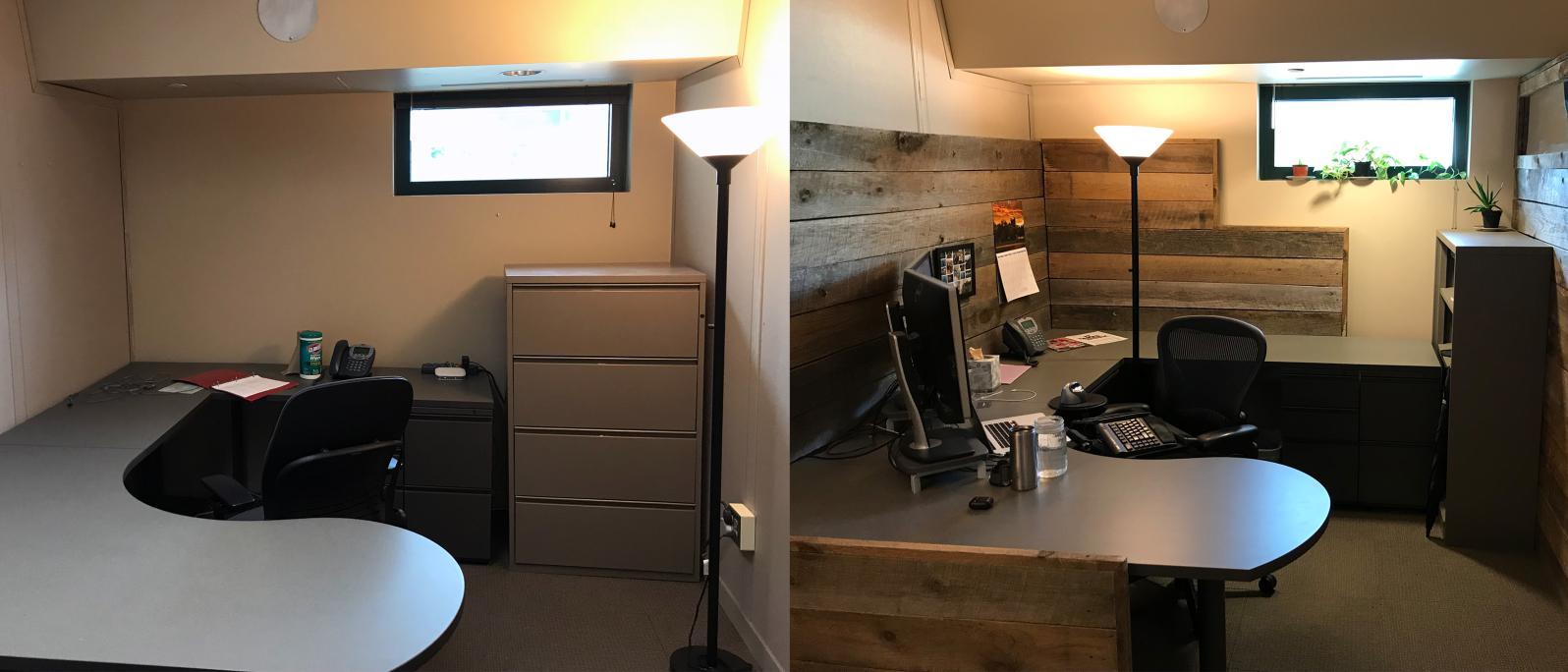
I used to dread going to work. My office space, originally built as a temporary partition, had become a long-term work "environment" that I experienced as dark, stale and lifeless. As a web developer, I yearned to spend less time in front of a computer and more time outdoors. I set up a part-time remote work arrangement, in part because I couldn't fathom spending 5 days a week there. Inspiration struck, however, and I found a way to not only transform my lifeless space, but also my experience of work and life itself. I now look forward to going to work most days, and smile every time I open the door to the sight and smell that awaits me upon arriving to my office.
I've come to realize that my daily life and experience is profoundly affected by the spaces I inhabit. If I spend my time in spaces that are deadened and lifeless, I both absorb and reflect that deadened experience. But at the same time, inspiration abounds a few clicks away, and the skills needed to complete a given project are just a youtube search from my fingertips. The transformation of my office cubicle described here is one of the best $100, 2 day projects I've ever imagined. Don't be fooled; I'm not an expert builder, and you can do this yourself with little more than a circular saw, some screws and a cordless drill. Here are the simple steps that made it possible, as well as some thoughts on the broader impact in my life and the world.
Step 1: Look for ways to bring the outside in
Let's start with the simple reminder that our ancestors evolved in nature, and therefore one of the best ways to enliven our spaces is to bring natural elements into them. Modern home and work environments are filled with manufactured products. Fire retardants, carpets, metals and plastics abound, and even when they're done tastefully, in my experience they don't offer the tranquility of wood, clay or stone.
Step 2: Become a frequent visitor to your local reuse center
Upcycling feels great! I love Ithaca ReUse, and I go there often just to keep an eye on what's available. I'm also on the mailing list, so I know when sales are happening. Two years ago, I found a set of weathered and broken sections of fencing during a 75% off building sale. I bought the lot for about $100, and it has proven remarkably versatile in application (as further described in From UX to YouX). I'm particularly lucky because I have a barn to store things that I'm not ready to use, but if you've ever seen a show like Salvage Dogs, you'll know that even window shopping at reuse centers can be a source of inspiration so consider making it a habit. However, you don't need to find the perfect source for your materials. I've seen people do amazing things with pallets, which you can likely find regardless of where you live.
Step 3: Engage your imagination
I've spent hours wading through Pinterest searches, just to get a lie of the land, so to speak. There's a gap, however, from the things that others have built, to the particular space that you want to enliven. Your imagination fills in the gap, as it envisions what is possible for a space. Give yourself time to just let your mind wander in your space and the possibilities, and then embrace playfulness as you begin to close in on an idea. Daydreaming is your friend.
Step 4: Sketch and plan
Limits are helpful to the creative process. Here's a list of some of the things I knew about my project:
-
Nothing could be screwed into the "walls" (it's basically a glorified cubicle, even if the walls extend up to the drop ceiling). I decided to take an "ask forgiveness not permission" approach. It was therefore essential that it be self-supporting, allowing me to assert that "it's just decoration" if the need arises. That being said, I did discuss it with my boss; so it wasn't a complete surprise.
-
Given that nothing would be screwed into the walls, I therefore wanted some right angle supports to provide stability. I also wanted to use my desk as further support, and didn't want to waste wood by filling in spaces below the desk, for example. This led to the idea of the small footer in front of my desk, as well as the back wall section.
-
Having only the one small window, I wanted to incorporate a mirror into the design, so that I could "add a window" to my office.
-
The facilities team didn't want to pay the supposed $800 to hang the white board, but having it propped on my desk was uncomfortable so I wasn't using it. I was also told that I couldn't hang it myself. Now, though, it's not hung on the wall. It's just supported by my decoration. ;)
-
Many barn wood accent walls are made of shorter pieces. Since I had longer pieces to choose from, I preferred to keep them long so that it would be quicker and easier to build (requiring fewer 2x2 framing strips) and also would be more versatile for reusing them on future projects.
I drew up some simple plans and measured the cuts. As all novice builders learn, "measure twice, cut once" is not only sound advice, it's also remarkably challenging at times. It happened numerous times that my repeated measurements were simply wrong, especially when the cuts were not perpendicular. It took me a few hours to cut all the boards, and another few hours to build the frames for the mirror and whiteboard. Most of that work was done with a simple circular saw, though I also used a table saw to rip the trim and a miter saw for the 45 degree cuts on the frames. It's surprisingly simple work, and my basic building philosophy (as a novice) is that by choosing natural materials, it alters one's expectations and increases my tolerance for imperfections. The boards themselves, after all, are far from "perfect."
Step 5: Build
The hardest part, by far, of the project, was simply negotiating the long boards up the staircase, through doors and hallways. I did this project by myself, and a helper would have made it easier for sure. But it was totally doable on my own. I used mostly 2x2s as the framing material, though I also grabbed a couple of old 2x4s so that I could better join the frames of the mirror and whiteboard to the surrounding wood pieces. After sliding the desk away from the cubicle wall, I slid 2x2 framing strips behind the desk and pushed it back into place. I used decking screws to attach the wood to the frame, which are definitely worth the extra money to me since they're practically impossible to strip and will easily allow me to take the decorations apart when I need to in the future.

Step 6: Transform the world
The most rewarding aspect of this project, by far, is the time I get to spend each day in my transformed space. It's impossible for me to know for sure, how much of my personal journey is being transformed by my space, and vice versa. What I know is that my experience of life is flowering exponentially at this time. When I walk into my office, the smell of wood is overpowering. The space has a warmth, depth and tranquility that passers by frequently remark about. I feel joy, repeatedly and regularly, while I'm at work. Going to work is no longer something I dread.
However, other aspects of my life are changing as well. I've started walking to my office most days rather than taking the bus, and I really cherish the time I get to spend in nature. I see possibilities, where before I only saw stress, anxiety, annoyance and problems. During those walks, I also wax philosophically about the world. You don't need me to tell you that for most of us, it's a dark time. What I notice, however, is that the world we've created is a reflection of the spaces we inhabit, both externally and internally. As I've learned to embrace my space, I notice clearly that the world I pay attention to is different that it was before. Rather than sitting on the bus and reading the dreadful clickbait news of the day, I'm walking through Ithaca's gorges and enjoying the changing fall colors.
Yes, we need to engage with the world that exists and the problems that we've created. But we also need to more fully embrace the world that we've created for ourselves. As more of us do that, the world cannot help but be transformed. The places that were deadened and deadening us will be less ubiquitous. The choices we make, both personally and collectively, will be life-giving choices, and we will subsequently be more alive, more joyful, and more grateful for the many blessings that we receive and create.



